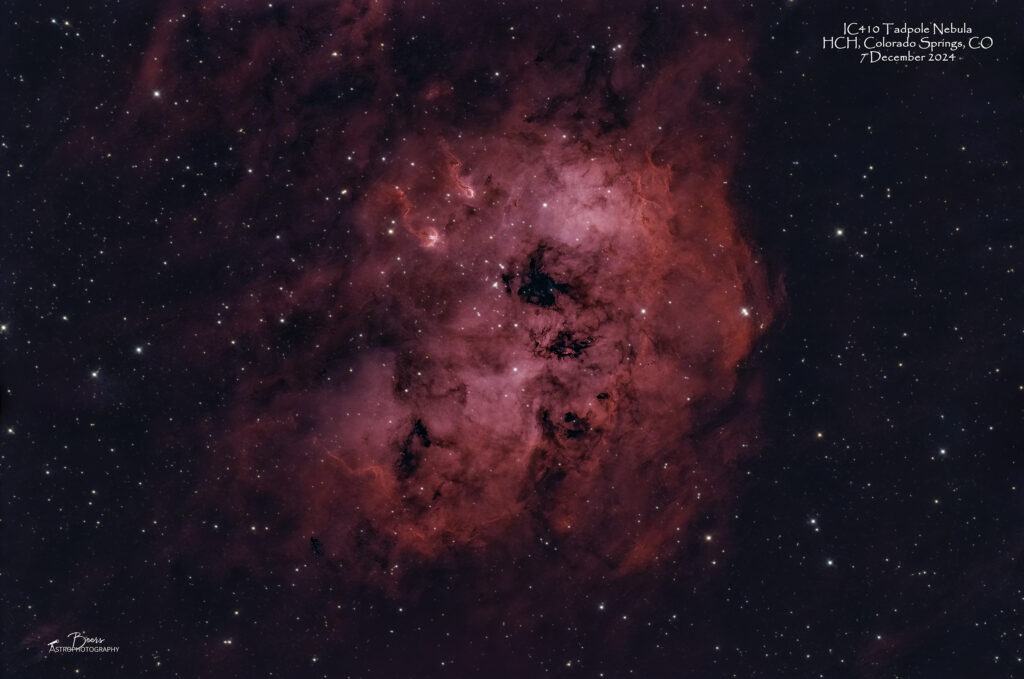
Target fun facts
The nebula known as IC 410 is home to a pair of intriguing structures popularly known as the “tadpoles.” These tadpoles, which consist of denser, cooler gas and dust, are approximately 10 light-years long and potentially sites of ongoing star formation. The tails of the tadpoles are caused by the radiation pressure and solar wind from the stars of NGC 1893; note how they point away from the star cluster. IC 410 is a faint and dusty emission nebula of more than 100 light-years across approximately 12,000 light-years away from Earth in the northern constellation of Auriga.
Other Catalog Designations: IC410, SH2-236, LBN807, Ced43
Subtype: Star Cluster associated with nebulosity
Distance from Earth: 12,000 light years
Size: 100 light year (diameter), 10 light year (length of Tadpoles)
Constellation: Auriga
{From: http://www.enchantedskies.net/IC410.htm, https://www.swagastro.com/ic4101.html, Stellarium}
Capture Notes
I spent a good portion of the day on Saturday, 7 Dec 2024 on the phone with HP Technical Support seeking a solution for the unplanned shutdown issue I’d been experiencing over the last week of imaging. I have always been extremely satisfied with HP Technical Support’s capabilities to diagnose and fix problems that I’ve had in the past with my HP laptops used for imaging control. This was most certainly the exception to that rule!
I first spoke with Zhana (0900-1300MST) – Case#5135168073. She remoted into my laptop, ran a sfc/ scannow and found no issues. She ran the HP Assistant. Downloaded an OS update that never completed. She was going to “Reset PC” when I objected to losing all my applications. I asked to speak with someone else – she said that was the only solution and others would give me the same answer. She transferred me to post-warranty support, who would not speak with me because it was a “purchased service” that I had not purchased.
I called back and spoke with Bernice (1300) – Case# 5135172742. She reset the power management system by having me unplug the laptop and hold the power button for 45 seconds. She had me run HP Support Assistant and HP Image Assistant and look to see if any updates were warranted – none were, so she said monitor the laptop and she would call back next Saturday (I was leaving for SAB trip to CA on Sunday morning) at about 1330.
Although I wasn’t planning to image over the night before I left for the SAB TDY, it was clear that night, so I did. The power down issue was better (the laptop only shutdown once during the night instead of the three times during the night of 4 December prior to the “fixes”) but not fixed. This image is the result of that night’s imaging / laptop experimentation session.
Sequence Plan (7Dec2024): Gain: 158, Temp: -0°C, offset=30. 82x5min. Total: 410 minutes (6:50hrs). Total capture time: 7Dec2024, 2030 – 8Dec2024, 0458. Images captured: 2030 – 2350MST (3:20hr) then shutdown; then 0031 – 0458MST (4:27hr) when I shut down the sequence. There were several minutes long breaks in the imaging throughout the night (2132-2135, 2237-2240, 2337-2340; and 0135-0141, 0219-0220, 0309-0317, 0322-0325, 0412-0418) perhaps due to autofocuser falling almost exactly at the one-hour point prior to the unplanned shutdown, then more randomly after the meridian flip.
Equipment
Equipment: All equipment controlled by DSO CTRL2 (after HP Tech Support initial call with Zaria and Bernice “troubleshot” the power shutdown issue to monitor the “fix”) HP Probook running Sequence Generator Pro v4.4.1.1441.
- Imaging (ASI2400-BB-FF-LPro): ZWO ASI2400MC imaging camera on (Big Bertha) Orion 8″ f/8 Ritchey-Chretien Astrograph Telescope, Teleskop Service (TS) 2.5” Rack and Pinon Focuser M90, Teleskop Service Flattener 1.0x for RC Telescopes (TS-RCFLAT2), Optolong L-Pro LP filter
- Autoguiding: Orion 60mm Multi-Use Guide Scope with Orion StarShoot AutoGuider Pro Mono Astrophotography Camera (controlled by PHD2)
- Autofocuser: ZWO EAF Electronic Automatic Focuser (EAF-5V-STD)
- Mount: Rainbow Astro RST-300 (controlled by iHubo ASCOM driver)
- Polar alignment: QHYCCD camera (controlled by Polemaster for polar alignment)
Summary
Capture: 7 December 2024, 82x5min. Total: 410 minutes (6:50hrs).
Shooting location: HCH, Colorado Springs, Colorado
Equipment: ASI2400MC on Big Bertha, Rainbow Astro RST-300
Processing: Captured in SGP, stacked in APP (HaOIII Color), star removal with Starnet++, processing with LR/PS
Other images of IC410 Tadpole Nebula

Capture Notes
All three of the weather apps (Weather Underground, Clear Skies, Astrospheric) gave different starting times for the clear skies – but none of them predicted what actually happened – clear night right after nightfall. So, I hustled to get Big Zeus set up on the front patio and got the process going. At about 2100, I woke up and took a look outside – it was completely cloudy and the sequence had ended due to a lost guide star. I was up and down for the next couple of hours until the skies were clear enough. They cleared at about 2230MST and stayed that way until the target set behind the house at about 0315MST.
Sequence plan: ISO3200; 71x300sec. Total exposure time: 5:37.5hrs. Captured 16Jan2023 1857 – 2025MST (17subframes, last deleted during culling for clouds); 16Jan2023, 2239 – 17Jan2023, 0325MST. (54 subframes, last deleted due to intersection with roof parapet, 3 in the middle culled due to clouds)
Equipment
Polar alignment: QHYCCD camera (controlled by Polemaster)
Imaging stream: Orion 10″ f/8 Ritchey-Chretien Astrograph Telescope, Canon EOS Ra with with Teleskop Service Flattener 1.0x for RC Telescopes (TS-RCFLAT2) and Optolong L-Extreme LP filter.
Mount: Sky-Watcher EQ6-R Pro Equatorial Mount (controlled by EQMOD)
Autoguider: Orion 60mm Multi-Use Guide Scope, Orion StarShoot AutoGuider Pro Mono Astrophotography Camera (controlled by PHD2)
All equipment controlled by HP Probook running Sequence Generator Pro v3.2.0.660.
Capture & processing notes
Capture: 16 January 2023; 71x300sec. Total exposure time: 5:37hrs
Shooting location: Colorado Springs, Colorado
Processing: Stacked in APP, processed in LR/PS.
